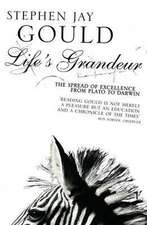Evolutionary Quantitative Genetics
Autor Derek A. Roffen Limba Engleză Paperback – 31 iul 1997
Preț: 1583.98 lei
Preț vechi: 1931.67 lei
-18% Nou
Puncte Express: 2376
Preț estimativ în valută:
303.09€ • 330.27$ • 255.40£
303.09€ • 330.27$ • 255.40£
Carte tipărită la comandă
Livrare economică 23 aprilie-07 mai
Preluare comenzi: 021 569.72.76
Specificații
ISBN-13: 9780412129711
ISBN-10: 041212971X
Pagini: 512
Ilustrații: XVI, 494 p.
Dimensiuni: 155 x 235 x 27 mm
Greutate: 1.58 kg
Ediția:Softcover reprint of the original 1st ed. 1997
Editura: Springer Us
Colecția Springer
Locul publicării:New York, NY, United States
ISBN-10: 041212971X
Pagini: 512
Ilustrații: XVI, 494 p.
Dimensiuni: 155 x 235 x 27 mm
Greutate: 1.58 kg
Ediția:Softcover reprint of the original 1st ed. 1997
Editura: Springer Us
Colecția Springer
Locul publicării:New York, NY, United States
Public țintă
ResearchDescriere
The impetus for this book arose out of my previous book, The Evolution of Life Histories (Roff, 1992). In that book I presented a single chapter on quanti tative genetic theory. However, as the book was concerned with the evolution of life histories and traits connected to this, the presence of quantitative genetic variation was an underlying theme throughout. Much of the focus was placed on optimality theory, for it is this approach that has proven to be extremely successful in the analysis of life history variation. But quantitative genetics cannot be ig nored, because there are some questions for which optimality approaches are inappropriate; for example, although optimality modeling can address the ques tion of the maintenance of phenotypic variation, it cannot say anything about genetic variation, on which further evolution clearly depends. The present book is, thus, a natural extension of the first. I have approached the problem not from the point of view of an animal or plant breeder but from that of one interested in understanding the evolution of quantitative traits in wild populations. The subject is large with a considerable body of theory: I generally present the assumptions underlying the analysis and the results, giving the relevant references for those interested in the intervening mathematics. My interest is in what quantitative genetics tells me about evolutionary processes; therefore, I have concentrated on areas of research most relevant to field studies.
Cuprins
Preface. Introduction. Heritability. The genetic correlation. Directional selection. Directional selection and the correlated response. Directional selection and the correlated response. Phenotypic plasticity and reaction norms. Sex-related effects on quantitative variation. Bottlenecks, finite populations, and inbreeding.The maintenance of genetic variation. A summing up. Glossary of terms. Glossary of symbols. References. Subject index. Taxonomic index.














